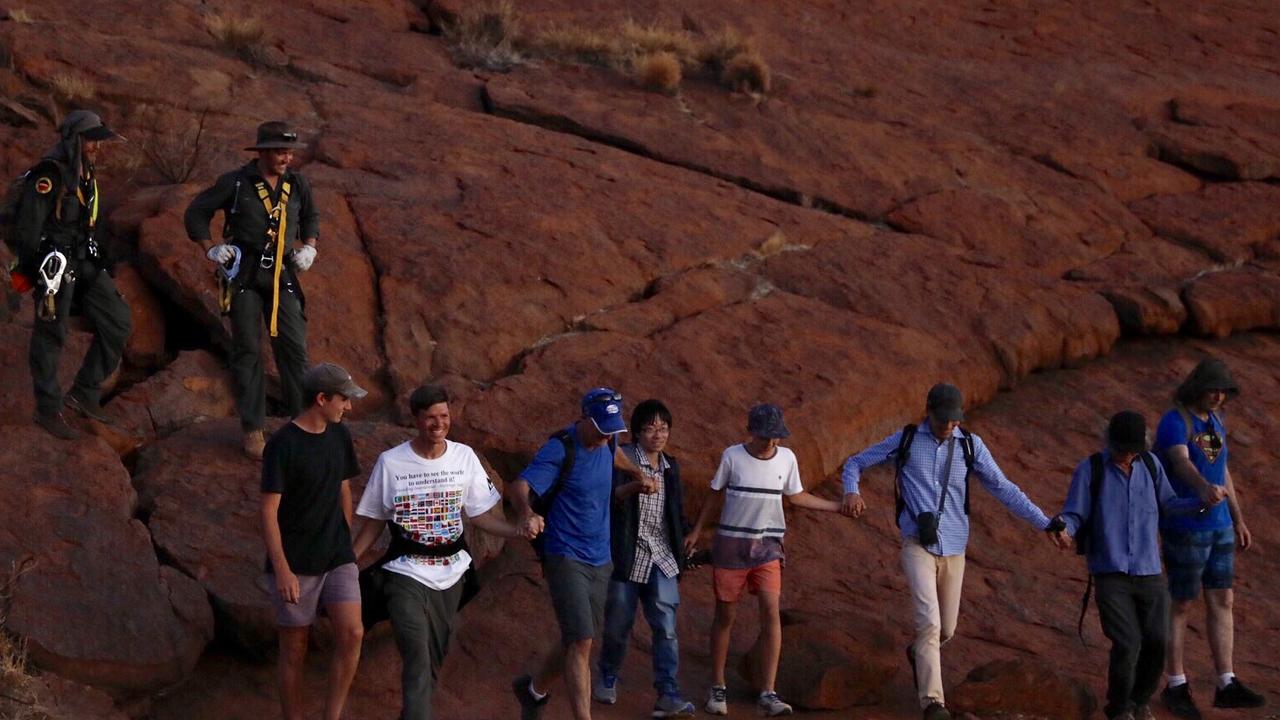Uluru: Final moments before climb’s closure
It has been filled with controversy and debate but the Uluru climb is now officially closed. This is the inside story of what happened after.

Public access to Uluru has been closed for good.
Rangers permanently closed the climb at 4pm Friday, and stopped any more people from making the trek.
After the closure, Anangu traditional owners celebrated at the base of the rock as a new sign was set up notifying visitors that the climb was now permanently closed.
The wishes of the Anangu — that people not climb the rock — will now be enforced by law, almost 34 years to the day since they were handed back the title to Uluru.
RELATED: Final scramble to Uluru ahead of climbing ban
RELATED: Celebrations as Uluru climb finally closed

They’ve waited for over two years to officially close the climb, after the ban was unanimously voted in by 12 members of the Uluru-Kata Tjuta National Park board in 2017, citing Uluru’s cultural significance to the Anangu people as outweighing economic considerations.
From today, climbing will be punishable by a $6,300 fine.
Parks Australia have said they will be running extra patrols over the weekend — and impose the heavy fine on anyone caught climbing.
The last climbers — a group of eight males — stepped off the rock at sunset on Friday.
RELATED: How much you’ll be fined for Uluru climb


In the lead up to October 25, the decision sparked frenzied scenes at the landmark, with scores of visitors queuing from dawn to make the final trek to the top.
There was a final scramble from visitors yesterday afternoon, hoping to climb the sacred rock before it closed permanently.
Nature seemed to be siding with indigenous Australians’ demand for Uluru to be respected as a sacred site when high winds threatened to prematurely end the generations-old tradition of climbing the rock before 4pm.
Rangers warned hundreds of anxious tourists who gathered at the base of the sandstone monolith before dawn that they would miss their last opportunity to ever scale its 348-metre summit unless blustery conditions subsided.
But the winds calmed and the first of around 1,000 climbers began their ascent at a chain handhold up the steep western face three hours later than scheduled.
An indigenous onlooker booed them.
RELATED: ‘Dangerous’ sight at top of Uluru


At 4pm, no new climbers were allowed to ascend, while those already on the rock had until sunset to find their way down.
A potential medical problem was reported with a climber, but authorities could not immediately provide details.
Over the decades, dozens of people have died while climbing Uluru for a range of reasons, including falls, dehydration and health issues.
Janet Ishikawa flew from her Hawaiian home to Central Australia to make the climb on the final possible day.
She likened the Uluru controversy to a furore over plans to build a giant telescope on Hawaii’s highest peak, which protesters consider sacred.
“It’s a total over-reaction. All of a sudden they want to take ownership of all this stuff,” Ishikawa said.
“They say you shouldn’t climb because of all this sacred stuff. I can still respect it and climb it.”
Chair of the board that banned the climb, Sammy Wilson, described the prohibition as a cause for celebration.
A curse will fall on all of them. They will remember how they defiled this sacred place until they die & history will record their contempt for Aboriginal culture https://t.co/0FbT1qINEl
— 💧Marcia Langton 🯠(@marcialangton) October 24, 2019
“If I travel to another country and there is a sacred site, an area of restricted access, I don’t enter or climb it, I respect it,” Wilson — a member of the Anangu tribe — said.
“It is the same here for Anangu. We welcome tourists here. We are not stopping tourism, just this activity.”
There has long been tension within the indigenous population around the money that climbers bring and the rock’s significance as a sacred site.
“I am happy and sad, two ways,” said Kevin Cooley, a resident of the Mutitjulu indigenous community in the rock’s shadow, who collects the Uluru tourists’ garbage. He fears that tourists numbers and the local economy will decline.
Chief executive of Ayers Rock Resort operator Voyages indigenous Tourism Australia, Grant Hunt, dismissed predictions of a significant decline in tourism.
“The travelling public have become much more culturally mature than they were 20 years ago,” Hunt said.
“Most people expect this and in fact want it to happen.”
“There’s a minority who still don’t, of course, and you always get that with any decision, but certainly our research and feedback says about 80% of people are supportive of the climb closing,” he added.
Signs around the rock have long discouraged climbing, describing Uluru as a “place of great knowledge” and noting that Anangu traditional law prohibits climbing.
Every person who trods across Uluru's surface today will pass this sign: pic.twitter.com/GHLzlgybTp
— Rachael Hocking (@Hocking_Rachael) October 25, 2019
The proportion of visitors who climbs has been steadily declining, with more than four in five respecting the Anangu’s wishes in recent years — who refers to tourists as “munga”, or ants.
The analogy was clearest in recent weeks with queues forming long before the climb opened at 7am each day at the base of the rock’s steep western face. From there, an eclectic mix of climbers begin their ascents in narrow columns.
Minister for indigenous Australians Ken Wyatt said he was disappointed by the final rush to climb the rock, which is renowned for its changing colours with the seasons and the time of day.
“It would be equivalent to having a rush of people climbing over the Australian War Memorial, if I can be so brazen in that regard, because sacred objects, community by community, are absolutely important in the story of that nation of people,” said Wyatt, who is indigenous.
Reaching the rock doesn’t guarantee the summit is attainable.
Climbing is often cancelled at short notice because of high winds or heat.
Denying climbers access to the World Heritage-listed landform is part of an evolution of the Australian narrative since British colonisation that has traditionally edited out the original inhabitants.
While the rock had been known as Uluru for thousands of years, British-born explorer William Gosse was credited with discovering it in 1873 and named it Ayers Rock after the then-premier of the British colony of South Australia, Sir Henry Ayers.
In 1993, it became the first official dual-named feature in the Northern Territory when it was renamed “Ayers Rock/Uluru.”
The order of the names was reversed a decade later at the request of regional tourism operators.
— With AP



